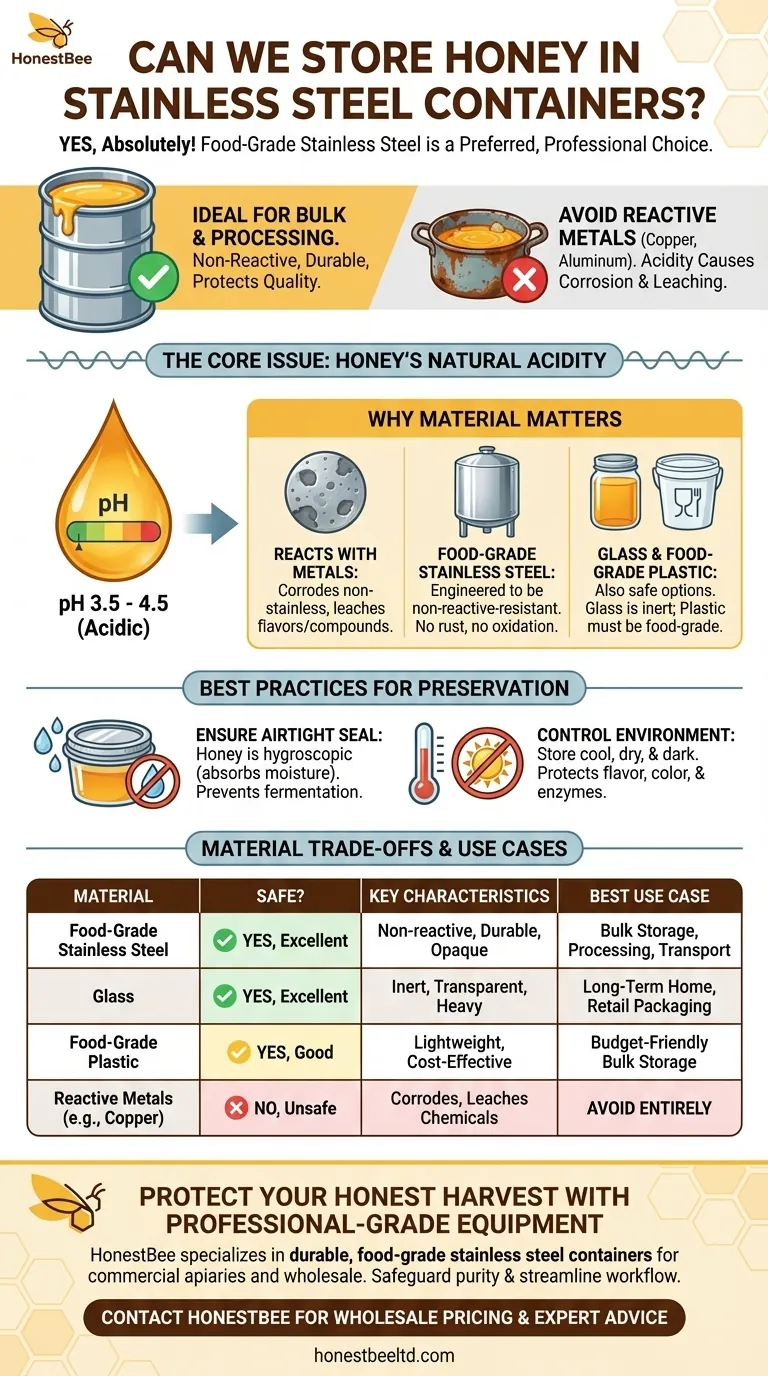Yes, you can absolutely store honey in stainless steel containers. In fact, food-grade stainless steel is a preferred material used extensively by beekeepers and commercial honey producers for processing and bulk storage. It is non-reactive, durable, and protects the honey's quality.
The core issue in honey storage isn't about one specific material being the only option, but rather about using a food-grade, non-reactive container. Honey's natural acidity can corrode or leach chemicals from improper materials, making the choice of container critical for both safety and quality.

Why Material Choice is Critical for Honey
Honey is a remarkable natural product, but its chemical properties demand careful handling. Understanding why certain materials are safe while others are not is key to proper storage.
The Acidic Nature of Honey
Honey is naturally acidic, typically with a pH between 3.5 and 4.5. This acidity is a key part of what makes it so resistant to spoilage from bacteria and other microbes.
However, this same acidity can react with certain materials over time, especially metals.
The Problem with Reactive Containers
When honey is stored in reactive containers like non-stainless steel, copper, or aluminum, its acids can corrode the metal. This process can leach metallic flavors and potentially harmful compounds into the honey, ruining its taste and making it unsafe to eat.
Similarly, using non-food-grade plastics can lead to chemicals leaching from the plastic into the honey.
The Benefits of Food-Grade Stainless Steel
Food-grade stainless steel is specifically engineered to be non-reactive and corrosion-resistant. This makes it an ideal material for handling acidic foods like honey.
It will not rust, oxidize, or leach any compounds into the honey, ensuring the product's purity remains intact. Its durability also makes it a long-lasting, reliable choice for beekeepers who need to store large volumes.
Best Practices Beyond the Container
While choosing the right container is the first step, how you store it is just as important for preserving honey's quality for months or even years.
Ensure a Perfect Seal
Honey is hygroscopic, meaning it readily absorbs moisture from the surrounding air. A poorly sealed container can allow moisture to enter, which raises the honey's water content and can lead to fermentation.
Always use a container with a tight-fitting, airtight lid.
Control the Environment
For optimal preservation, store honey in a cool, dry, and dark location.
Warm temperatures can degrade the honey's flavor and color over time. Keeping it in a dark place, like a pantry, protects it from direct sunlight, which can break down its valuable enzymes.
Understanding the Trade-offs: Stainless Steel vs. Glass
Both stainless steel and glass are excellent choices, but they serve different primary purposes.
The Case for Stainless Steel
Stainless steel is the workhorse of the honey industry. It is unbreakable, lightweight compared to glass of the same volume, and completely opaque, which automatically protects the honey from light.
This makes it the superior choice for bulk storage, transport, and processing environments.
The Case for Glass
Glass is considered the gold standard for long-term pantry storage and retail packaging. Like stainless steel, it is completely inert and non-reactive, ensuring the honey's flavor remains pure.
The transparency of glass also allows you to easily see the honey's quality and state of crystallization.
Materials to Unequivocally Avoid
Never store honey in containers made of reactive metals like copper, brass, aluminum, or galvanized steel. Always ensure any plastic container you use is explicitly marked as food-grade.
Making the Right Choice for Your Needs
Selecting the best container depends entirely on your specific goal.
- If your primary focus is bulk storage or processing: Food-grade stainless steel is the professional standard for its durability, opacity, and non-reactive properties.
- If your primary focus is long-term home storage: Glass jars with airtight lids are ideal for preserving the purity and flavor of your honey indefinitely.
- If your primary focus is a budget-friendly, safe option: Look for high-quality, food-grade plastic buckets with well-sealing lids.
Choosing a safe, non-reactive container is the most important step you can take to protect the quality and integrity of your honey.
Summary Table:
| Storage Material | Safe for Honey? | Key Characteristics | Best Use Case |
|---|---|---|---|
| Food-Grade Stainless Steel | Yes, Excellent | Non-reactive, durable, opaque, corrosion-resistant | Bulk storage, processing, transport |
| Glass | Yes, Excellent | Inert, non-reactive, transparent | Long-term home storage, retail packaging |
| Food-Grade Plastic | Yes, Good | Lightweight, cost-effective | Budget-friendly bulk storage |
| Reactive Metals (e.g., Copper, Aluminum) | No, Unsafe | Can corrode and leach into honey, ruining flavor and safety | Avoid entirely |
Protect Your Honey Harvest with Professional-Grade Equipment
As a commercial beekeeper or distributor, the quality of your honey is your reputation. Storing and processing it in the right equipment is non-negotiable. HONESTBEE specializes in supplying durable, food-grade stainless steel containers and other essential beekeeping supplies designed for the demands of commercial apiaries and wholesale operations.
We help you safeguard your product's purity, streamline your workflow, and ensure customer satisfaction. Let's discuss the best storage solutions for your scale.
Contact HONESTBEE today for wholesale pricing and expert advice.
Visual Guide

Related Products
- Food Grade Plastic Honey Bucket Pail for Beekeeping
- Stainless Steel Pail Perch Bucket Bench
- Classic Drum Shaped Glass Honey Jar with Airtight Lid
- Inverted Squeezable Honey Jar with No Drip Flip Top Cap for Easy Pouring
- Stainless Steel Honey Press Wax Press with Tank
People Also Ask
- What type of packaging is used for honey? A Guide to Glass, Plastic & Pouches
- What are plastic buckets called? The Essential Guide to Plastic Pails
- Why might producers choose plastic containers for honey? A Guide to Cost-Effective & Durable Packaging
- What are the benefits of honey pouches? A Guide to Cost-Effective & Convenient Packaging
- Can you store honey in a plastic bucket? Yes, with the right food-grade HDPE.



















